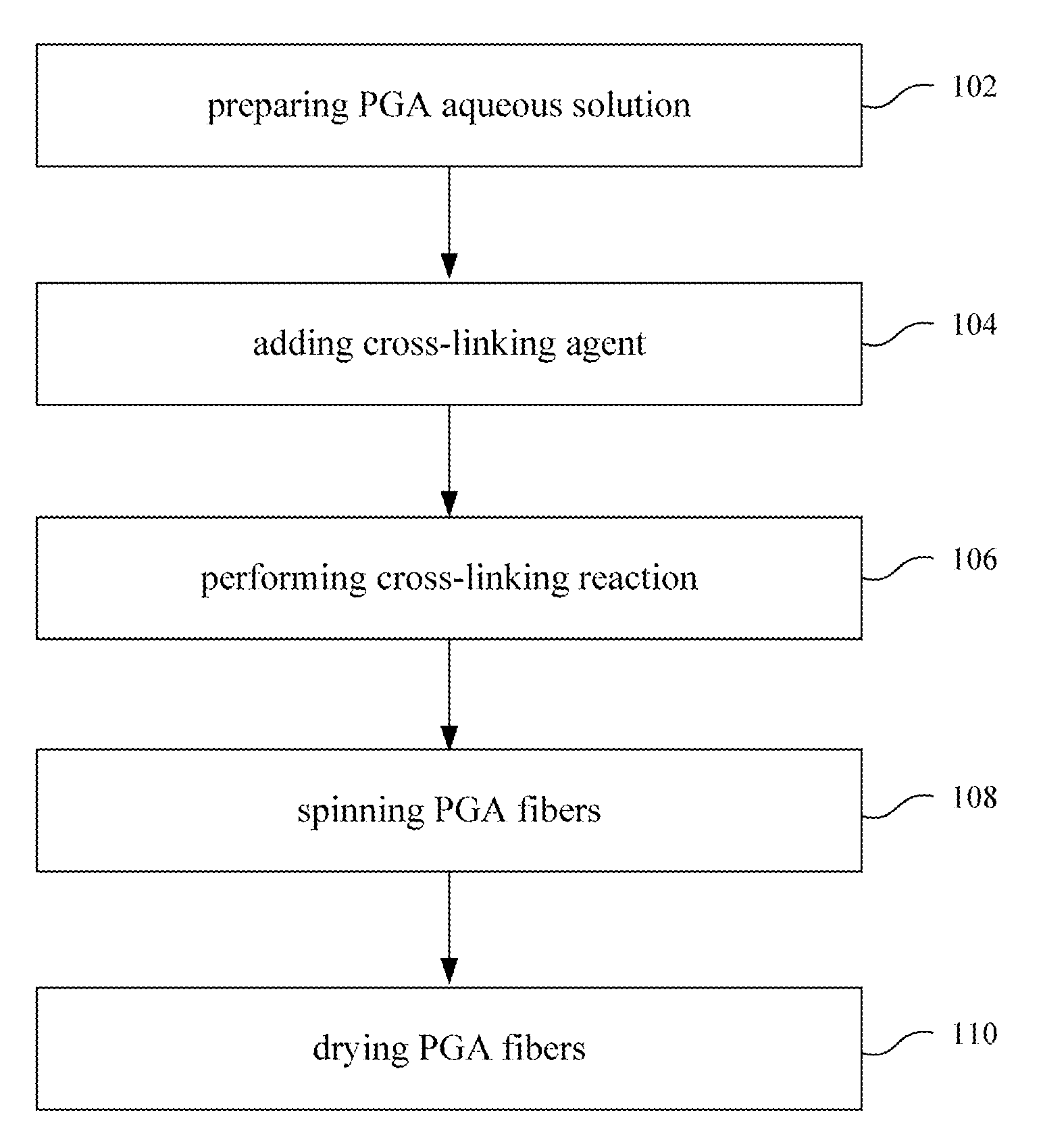Process of making water-insoluble polyglutamic acid fibers
a technology water-insoluble polyglutamic acid, which is applied in the direction of monocomponent polypeptide artificial filaments, melt spinning methods, yarn, etc., can solve the problems of limited water-absorption ability, environmental problems, and cost and biodegradability of polyglutamic acid fibers
- Summary
- Abstract
- Description
- Claims
- Application Information
AI Technical Summary
Benefits of technology
Problems solved by technology
Method used
Image
Examples
embodiment 1
[0036]Sodium polyglutamate (from Vedan Corp.) was mixed with water to prepare a 6 wt % of PGA solution. The initial viscosity of the PGA solution was 56.4 cp.
[0037]Next, a cross-linking agent, ethylene glycol diglycidyl ether (from TOKYO YASEI), was added into the PGA solution. The added amount of the ethylene glycol diglycidyl ether was 7 μL / 100 g PGA solution, which was equal to ¼ equivalent of ethylene glycol diglycidyl ether per equivalent of PGA. After adding the cross-linking agent, the PGA solution was stirred at a speed of 50 rpm to have the cross-linking reaction performed under 60° C. If the cross-linking reaction was not interrupted until the time of “rod climbing,” which took about 5.5 hours, the rod-climbing viscosity was 997.2 cp.
[0038]The spinning test was performed when the viscosity was increased to 82 cp (about 240 minutes) to let the PGA solution pass the spinning nozzle for obtaining PGA fibers. In order to prevent the PGA solution from being over cross-linked be...
embodiment 2
[0040]The operation conditions of Embodiment 2 were about the same as those of Embodiment 1. The only difference was the concentration of the initial PGA solution was 10 wt %, and the added amount of ethylene glycol diglycidyl ether was 5 μL / 100 g PGA solution, which was equal to 1 / 9 equivalent of ethylene glycol diglycidyl ether per equivalent of PGA.
[0041]The initial viscosity of the PGA solution was 60.2 cp, and the rod-climbing viscosity was 1247.4 cp (cross-linked for about 2.3 h). In this Embodiment, the spinning started when the viscosity of PGA solution was 92.3 cp (about 40 minutes). The PGA fibers can be successfully obtained.
embodiment 3
[0042]The operation conditions of Embodiment 3 were about the same as those of Embodiment 1. The only difference was the concentration of the initial PGA solution was 15 wt %, and the added amount of ethylene glycol diglycidyl ether was 5 μL / 100 g PGA solution, which was equal to 1 / 14 equivalent of ethylene glycol diglycidyl ether per equivalent of PGA.
[0043]The initial viscosity of the PGA solution was 74.6 cp, and the rod-climbing viscosity was 964.8 cp (cross-linked for about 2.2 h). In this Embodiment, the spinning started when the viscosity of PGA solution was 152.1 cp (about 90 minutes). The PGA fibers can be successfully obtained.
PUM
| Property | Measurement | Unit |
|---|---|---|
| temperature | aaaaa | aaaaa |
| temperature | aaaaa | aaaaa |
| cross-linking temperature | aaaaa | aaaaa |
Abstract
Description
Claims
Application Information
 Login to View More
Login to View More - R&D
- Intellectual Property
- Life Sciences
- Materials
- Tech Scout
- Unparalleled Data Quality
- Higher Quality Content
- 60% Fewer Hallucinations
Browse by: Latest US Patents, China's latest patents, Technical Efficacy Thesaurus, Application Domain, Technology Topic, Popular Technical Reports.
© 2025 PatSnap. All rights reserved.Legal|Privacy policy|Modern Slavery Act Transparency Statement|Sitemap|About US| Contact US: help@patsnap.com


